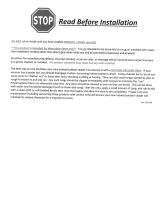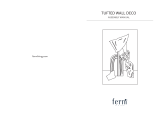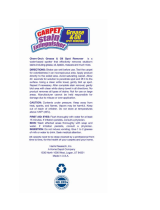Page is loading ...

Modular Carpet Tile Maintenance
Establishing a maintenance program can measurably reduce cleaning costs and greatly extend the useful life and
attractive appearance of your modular tile. Regular maintenance also helps to maintain indoor air quality. Because
many energy ecient buildings now recirculate a lower percentage of outside air, whatever is brought into the
building- including dust, dirt and allergens- remains unless it is mechanically removed. Most of it is heavier than air
and falls to the tile, where it is trapped and easily removed by regular vacuuming and routine maintenance. Good air
quality is sustained as well as clean carpet.
A good maintenance program keeps both tracked-in and airborne soil buildup to a minimum through prevention, daily
cleaning and spot removal, and periodic deep cleaning. This guide outlines these key components on the following
pages to help you develop an eective plan. For maximum results, the plan should be implemented as soon as the
tiles are opened.
How to prevent soiling
Identify Key Trac Areas. Since 85% of soil is tracked in on dirty shoes, use a floor plan to anticipate where it will
localize.
First identify light-, medium- and heavy-trac carpet areas, then match them to an appropriate maintenance
schedule. You should expect the highest trac in:
• Track-o areas where tile and hard surfaces meet, including outside entrances, restrooms, etc.
• Funnel areas where trac is channeled or confined, such as doorways, elevators and vending machines.
Choose Your Color Wisely
Plan color, pattern and texture to accommodate trac levels and local soil color. In general,
light shades are best in small areas where there is less soil. Darker earth tones mask dirt and are excellent in high-
trac zones. Extremely dark shades, however, tend to reveal dust and lint and should be avoided near entrances or
adjacent to hard floors. Middle-toned patterns, prints and heathers hides stains well, while textures of varying pile
heights help camouflage uneven soiling for a more uniform look.
Install Walk-o Mats
Locate soil-absorbing barriers at all building entrances, lobbies and elevators. Mats should be
cleaned frequently so they don’t become sources of tracked-in soil themselves, especially in inclement weather.
Carpet the Elevators. Elevators take the brunt of foot trac and soiling. Adding removable elevator carpets, fastened
with Velcro or double-sided tape for easy cleaning, helps capture accumulated dirt before it reaches the tiled floors.
Daily vacuuming is essential
More than any other factor, daily vacuuming of all high-trac areas determines the life of the carpet. Even when
soil is not visible, vacuuming high-trac areas will reduce the amount of maintenance time for tile in more removed
locations. You can retain the clean appearance of the entire tile installation by concentrating on this relatively small
portion-usually less than 30%. Following the floor plan, a daily vacuuming schedule should be established by the time
the installation is ready for use. As a general guideline, a thorough daily cleaning should include eight passes by the
machine in all key areas. Be sure that the proper equipment is available to get the job done right. It is vital to select
and use equipment that is appropriate to the environment, degree of foot trac and volume.
Equipment
A heavy-duty upright vacuum is the best choice for eective daily carpet tile care - including one for each floor in
larger installations. It should be sturdy, easy to handle and provide good brush action for high air flow.

Results of laboratory testing show that vacuum cleaners with a rotating brush and beater action are the most
eective in loosening and removing deeply embedded soil. The action of the brush disturbs and agitates the pile
surface and brushes soil particles from the fibers. Then the strong suction of the vacuum pulls the particles from the
tile. Wand-type machines provide only suction and minimum fiber agitation.
Spot and stain removal
In addition to routine vacuuming, spot removal should be done daily as needed, by a well-trained attendant. Prompt
treatment is critical. The longer a spot is allowed to set, the more dicult it is to remove. Some spots will become
permanent stains if allowed to remain until dry.
Give immediate attention to trouble spots like tracked-in grease, food, beverages and chemical spills. In hospitals and
institutional settings where frequent spills occur, immediate cleaning is especially important to avoid chemically set
stains. As a last resort, replace stained or damaged tile with new ones from attic stock or from less visible areas of the
installation. A color dierence could occur depending upon tiles condition or exposure.
Supplies to keep on hand
For small areas, commercial spot removal kits are ideal. They include detergents, solvents and several types of special
spotting agents for inks, dyes, blood and urine, plus basic equipment and directions. Most kits require no special skill
and are eective on most stains. You also can make your own. For your convenience, this guide includes directions for
preparing cleaning solutions. Cleaning procedures also are included for removing many specific stains. As a
precaution, all cleaning materials should first be tested on an inconspicuous area to assure that they don’t aect
color. Put several drops of the agent on a white cloth, then blot the tile. Do not use the agent if the color transfers to
the cloth. For large areas, a wet/dry vacuum also is useful to draw up the spill, the detergent and rinse water. This
lessens spot spreading and quickens drying time.
General Spot Removal
Remember! Spots need prompt attention. Attend to spot removal as soon as possible.
A. Identify the substance causing the spot, if possible.
B. Gently scrape up any solid material with a spoon or dull spatula.
C. Blot up all liquid using a clean, all white cloth or paper towel.
D. Apply a cleaning chemical or detergent spotter to another clean cloth and blot - do not rub - the stained area.
Do not pour the liquid directly onto the tile. Avoid overwetting, which could damage the secondary backing.
E. Begin at the edge of the spot and work toward the center, repeating the blotting action until no more of the spot
is deposited onto the clean cloth.
F. After the majority of the spot has been removed, put several thicknesses of paper towels or facial tissue on the
area, add a light weight and allow to dry. This will wick up any remaining stains from the carpet tufts.
Special help for special needs
Occasionally, some spots and spills require specialized care to prevent staining. Industrial chemicals (floor and tile
cleaners, bleach, etc.) often contain potentially harmful chemicals. Immediate action is vital. Vacuum solid material
first, then remove the remainder with cold water. Heat only worsens the harmful eects. When the stain’s cause is
unknown, first try to remove the stain with a cleaning solvent or an absorbent cleaner such as Host® or Capture®.
If this isn’t successful, use a detergent solution that dries to a powder, leaving no sticky residue. KRAUS does not
recommend the use of a bonnet cleaning system, as it can damage the fibers in your carpet. Use will void any
warranties.
Periodic deep cleaning
All carpet tiles, no matter how resistant to dirt and stains, will eventually build up a layer of oily, sticky soil that is not

removed by vacuuming, If this solid is allowed to remain, it will bond to the carpet fiber, causing matting and unsightly
trac lanes. Periodic deep cleaning delays replacement and extends the life of the carpet. There are several methods
for deep cleaning carpet tiles that you may select, each with advantages and disadvantages.
These include:
• Dry foam
• Dry extraction
• Hot water extraction
Eective interim maintenance methods are the dry foam method such as “Von Schrader,” Chemdry, or the dry
extraction method such as Host® or Capture®. They are all quick-drying and leave a minimum detergent residue.
Some areas may require the deeper cleaning method of hot water extraction. Hot water extraction improves the
appearance and usable life of the tile. It drives hot water and detergent down into the pile under pressure, flushing out
heavy soil and micro-organisms. The results are comparable to in-plant cleaning. Operator training is important with
any deep cleaning system, but expertise is particularly critical for hot water extraction. When properly performed, hot
water extraction will not damage the carpet because none of the detergent penetrates the primary backing and gets
into the latex to cause delamination.
Choose the best system for your tile based on the degree of soiling and the available level of operator proficiency.
Most franchisers and many owner/operator systems provide excellent training and support to users of their systems.
Minor repairs
Occasionally, it may be necessary to make a few minor repairs to the carpet. Below are some suggestions foR tile care.
Depressions: If furniture or heavy objects remain in one position too long, some depressions in the surface of the carpet
may appear. To repair, shift furniture slightly, then brush the area with your fingertips to loosen pressed tufts. If the
depression remains after several days, hold a steam iron several inches above the carpet. Do not let the iron touch the
carpet or saturate it with water. Again, brush the tufts to blend with the surrounding area.
Edge Sprouts: Kraus’ uniquely styled tiles are the result of advanced tufting processes, precision shearing and the
use of heavy face weights. Tiles of heavier face weights often have excess yarn bundles surface as the tiles are slid
together during installation. Removal of excess yarn along the tile’s edge is performed during the installation or shortly
thereafter. If yarn tufts appear higher than they should, after the installation simply stand them up between your
fingers and clip the excess yarn with scissors. This is normal with heavy weight tiles.
Snags: Snags most often occur in loop pile that’s caught by shoe nails, rough vacuum attachments or other rough
objects. Snags should be clipped like sprouts immediately. Never pull them.
Burns: Pile fiber which has been burned is melted and destroyed and cannot be restored. Have the tile replaced.
Shedding: Regular vacuuming will easily remove loose carpet fibers that often appear in new cut pile carpets. Be sure
to install carpet tiles under temperature and humidity conditions average to the building.
Fuzzing: Most apparent in older loop pile tiles, fuzzing is caused by embedded grit and surface wear breaking down
the fibers. Loose fibers, still bound at one end, stick up and can be carefully clipped o. To avoid fuzzing, keep the
carpet clean. Consult your dealer or professional cleaner if fuzzing is extensive.
Pilling: After extensive wear, “pills” can appear on the pile surface. These small balls of entangled fibers and lint can be
safely clipped o.

Cleaning solutions
• Detergent: Mix ¼ teaspoon of a dishwashing liquid that doesn’t contain lanolin or bleach,
with one quart of lukewarm water.
• Vinegar: Mix 1/3 cup of white vinegar with 2/3 cup of water.
Enzyme Detergent: Mix one teaspoon of enzyme presoak, such as BIZ®, with one cup of warm water.
• Ammonia: Mix one tablespoon of clear household ammonia (3% solution) with ½ cup of water.
• Solvent: To protect the latex backing, use a dry solvent such as Picrin®, Energine®, Carbona®,
or K2R® in small amounts only.
• Absorbent Cleaners: Host®, Capture®, and Blue Luster Dry® also are excellent for removing large spots.
Spot removal guide
A: Solvent, blot, detergent, blot, water, blot
B: Detergent, blot, ammonia, blot, detergent, blot, water, blot
C: Detergent, blot, vinegar, blot, ammonia, blot, detergent, blot, water, blot
D: Detergent, blot, vinegar, blot, detergent, blot, water, blot
E: Detergent, blot, ammonia, blot, vinegar, blot, water, blot
F: Use cold ingredients: water, blot, detergent, blot, ammonia, blot, detergent, blot, water, blot
G: Freeze with ice cubes, shatter with blunt object, vacuum, solvent, wait, blot, repeat if needed
H: Blot, water, blot, ammonia, blot, detergent, blot, water, blot
Beer A Ketchup B
Blood F Mascara A
Butter A Mayonnaise B
Chewing Gum G Milk B
Cheese B Nail Polish A
Chocolate B Paint (Latex) A
Cocktails D Rust D
Coee D Shoe Polish A
Crayon A Soft Drinks D
Egg B Soya Sauce B
Excrement B Tar A
Fruit D Tea D
Furniture Polish A Toothpaste B
Garden Soil B Type Ribbon A
Glue (White) B Urine (Fresh) H
Grease A Urine (Dry) C
Hair Spray A Vomit E
Ice Cream B Wax (Candle) G
Ink (Point/Felt) A Wax (Paste) A
Ink (Permanent) E Wine D
/








